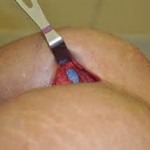Buttock implant augmentation has historically been plagued by a high rate of complications. Since the intramuscular technique for implant location was introduced in the mid-1990s, the rate of complications has decreased and more natural and long-term results have been obtained. Its advantages over the subfascial location has led to more patients considering the procedure although it is important to realize there are size limitations of the implants that can be placed (300cc to 350ccs) due to the greater restriction of the intramuscular pocket space.
But with the increase in the numbers of such buttock implant surgeries being performed has come a new set of complications unique to the procedure. While incisional dehiscence and seroma are still the most common postoperative problems that can occur, implant displacement out of the intramuscular pocket (herniation) is now being recognized as another potential complication that can occur.
In the October 2014 issue of the journal Plastic and Reconstructive Surgery, an article was published entitled ‘Gluteal Implant Displacement: Diagnosis and Treatment’. The purpose of this paper was to describe, classify and standardize the treatment of buttock implant displacement. A cadaver study was done to determine the least intramuscular overlying muscle thickness needed for safe intramuscular dissection. This was shown to be a minimum of 2 cms. Over a three year period, 24 patients were treated for visible buttock implants. Treatment consisted of implant removal, radial capsulotomies, capsular pocket plication, and intramuscular pocket dissection. An anchoring suture was placed at the lateral edge of the muscle incision to prevent muscle rupture during implant insertion. This one-stage approach for implant relocation resulted in only one implant (3%) out of 47 patients that subsequently developed displacement back into the more superficial pocket.

Dr. Barry Eppley
Indianapolis, Indiana


